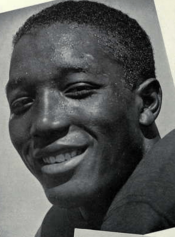Julius Franks facts for kids

Julius Franks, c. 1942
|
|
| No. 63 | |
|---|---|
| Position: | Guard |
| Personal information | |
| Born: | September 5, 1922 Macon, Georgia |
| Died: | November 26, 2008 (aged 86) Grand Rapids, Michigan |
| Height: | 6 ft 0 in (1.83 m) |
| Weight: | 187 lb (85 kg) |
| Career information | |
| High school: | Hamtramck (MI) |
| College: | Michigan |
| Undrafted: | 1944 |
| Career highlights and awards | |
|
|
Julius Franks, Jr. (born September 5, 1922 – died November 26, 2008) was an important leader for civil rights. He was also an amazing All-American football player. He played as a guard for the University of Michigan from 1941 to 1942.
Franks wore jersey number 62 in 1941 and number 63 in 1942. He was one of the first African-American players at the University of Michigan to become an All-American in football. Sadly, an illness ended his college sports career early.
After his time at Michigan, Franks became a dentist. He was also a very active community leader. He spent a lot of his time helping others. He even helped to make Grand Rapids, Michigan a more integrated city. He did this by helping to pay for homes in a neighborhood that was mostly white.
Contents
First African-American All-American
Julius Franks was born in Macon, Georgia. He grew up in Hamtramck, Michigan. In 1939, he was named to the all-city team in Detroit, Michigan, for his football skills.
He was the son of Julius Franks, Sr. and Nellie Mae Solomon. He had children named Daryl, Cheryl, Bobby, Beverly A Grant, and Fredrick. After high school, he went to the University of Michigan. He was the third African-American to play for the Michigan Wolverines football team.
Earning All-American Honors
In 1942, Franks made history. He became the first African-American at Michigan to earn All-American honors. Some records say he was the second, but he was definitely one of the first.
His coach, Fritz Crisler, said Franks was one of the hardest-working players he ever coached. The 1942 Wolverines' offensive line was very strong. It included Franks, Al Wistert, Robert Kolesar, Merv Pregulman, and Elmer Madar. They were known as the "Seven Oak Posts." Franks believed their success came from practicing against the 1940 team. That team had famous players like Tom Harmon, Forest Evashevski, and Bob Westfall.
In 1942, Franks played every minute of his games as a junior. He was named a first-team All-American by several groups. These included the International News Service, Central Press, and Collier's Weekly. The Associated Press and New York Sun named him a second-team All-American.
Illness and Recovery
In 1943, Franks and his teammate Tom Kuzma got tuberculosis. They had to stay in University Hospital for 25 months to get better. Franks remembered that Coach Fritz Crisler visited him often. Even team star Tom Harmon came to visit while on leave from the military.
Because of his illness, Franks missed his senior year of football. He earned his Bachelor of Science degree in 1947.
In 1982, Franks was honored by the University of Michigan. He was named to the University of Michigan Hall of Honor. He was the twelfth Michigan football player to receive this special award.
Life as a Dentist and Community Leader
In 1951, Julius Franks earned his D.D.S. degree. This means he became a dentist from the University of Michigan Dental School. He worked as a dentist in Grand Rapids, Michigan for over 40 years.
Franks was a leader in many community groups. These included the Urban League, United Way, American Red Cross, Boy Scouts of America, and Rotary Club.
Public Service and Integration Efforts
In 1964, Michigan Governor George Romney chose Franks to be on the first Board of Trustees for Western Michigan University. He served as a trustee there until 1983. Franks also served on many other boards. These included the Kent County Dental Society and the Michigan & American Dental Association.
In 1992, Franks got sick with Guillain–Barré syndrome. This illness made him retire from dentistry.
In the 1960s, Franks played a big part in helping to integrate Grand Rapids. At that time, African Americans were often not allowed in "white" middle-class neighborhoods. Real estate agents would not show them houses.
In 1962, Franks' friend, J.E. Adams, found some empty land. It was planned to be a park. Adams, Franks, and their friends Joseph Lee and Samuel Triplett came up with a plan. They decided to buy the 20 acres (80,937 m2) land. They wanted to build a middle-class neighborhood for African-Americans.
When they announced their plan, it caused a lot of trouble. There were protests, lawsuits, and even threats. Banks refused to give them money for the project. So, the four men bought the land themselves for $60,000. They started building the homes. The first of 51 houses was finished in 1965.
Today, this neighborhood is called Auburn Hills. It has a population of 542 people. It also has the lowest crime rate in Grand Rapids. In 2006, the Michigan Alumni Club gave Franks a special award. It was called the "Paul G. Goebel, Sr. Distinguished Alumni in Athletics Award." In his later years, Franks continued to be a leader in many groups.
See also
- University of Michigan Athletic Hall of Honor

